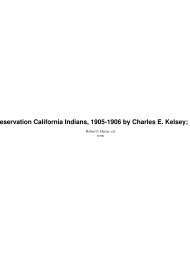X— MY LAST PATROLCHAPTER IPIONEER TRAILS OF THE WESTFrom the beginning <strong>of</strong> the 16th century people <strong>of</strong> all nations wanted to reach California. The Spanish approached it from the south,the Russians from the north, the French via the Mississippi River <strong>and</strong> the St. Lawrance River, the English from Canada, <strong>and</strong> the Dutcharound the Horn. The Americans approached in an ever advancing wedge.Pioneers approaching from the east encountered several barriers, the Rocky Mountains, the deserts, <strong>and</strong> the Sierras. Those from thenortheast crossed the Rockies, <strong>and</strong> those approaching from the middle crossed the Utah desert to the Sierras. The <strong>Yosemite</strong> region wasthe last portion <strong>of</strong> the Sierra to be crossed.<strong>Trails</strong> were opened at both ends <strong>of</strong> the Sierra long before this region was known. The opening <strong>of</strong> trails to this region was not done<strong>by</strong> the 49’ers. The Spanish opened trails across the mountains at various passes from Panama to Tehachapi. In 1774, Anza exploreda route across the Colorado Desert to the Sierras, thence to San Jacinto Valley <strong>and</strong> Mission San Gabriel. In 1775-76, Father Garcias,a friend <strong>of</strong> Anza, ascended the Colorado River to Mojave Desert, following thence along the line <strong>of</strong> the Cajon Pass, <strong>and</strong> south to SanBernardino <strong>and</strong> San Gabriel. He crossed Tejon Pass to Tulare County <strong>and</strong> then made his way across Arizona to its northeast corner,visiting the Hopi Indians.Tehachapi Pass was the most northerly pass opened <strong>by</strong> the Spanish. The Spaniards’ northern trails were cut <strong>of</strong>f in the beginning <strong>of</strong> the18th century. The Yumas rebelled in 1781, cutting <strong>of</strong>f the Anza Trail. The hostility <strong>of</strong> the Hopi <strong>and</strong> Navajo prevented the development<strong>of</strong> the Mojave trail which Anza had explored. By 1812, the northern passes had been discovered <strong>by</strong> British <strong>and</strong> American fur traders.Alex<strong>and</strong>er Mackenzie crossed the continent in the far north. There was a race between the “Northwesters” <strong>and</strong> the Hudson Bay men,the former generally in advance. The Americans came just behind them.Lewis <strong>and</strong> Clark on their expedition to the Pacific Coast had explored as far south as the Snake River in southern Washington, leaving anunknown gap almost the full length <strong>of</strong> the Sierras. As time went on the Spanish found no new passes but explored <strong>and</strong> named Mariposa<strong>and</strong> Merced.Gabriel Moraga, who came to California when very young with Anza, <strong>and</strong> who succeeded his father in the comm<strong>and</strong> <strong>of</strong> the Presidio<strong>of</strong> San Francisco, explored the interior valleys <strong>of</strong> California between 1800 <strong>and</strong> 1820, Visalia was a favorite spot <strong>and</strong> was destined tobe the site <strong>of</strong> the capital <strong>of</strong> the new territory, but, no doubt, the discovery <strong>of</strong> gold in 1848 changed all this. Sacramento grew rapidly<strong>and</strong> became the State Capital.Moraga made more than forty expeditions to the interior. In 1806 he discovered the Merced River. On this expedition he started fromSan Juan Bautista, making his way eastward via Pacheco Pass, striking the San Joaquin Valley near the Mariposa <strong>and</strong> Merced Rivers.The name “La Mariposas” comes from the Butterflies which Moraga’s party found in abundance. One <strong>of</strong> Moraga’s corporals <strong>of</strong> theexpedition had one in his ear <strong>and</strong> mentioned the fact that the butterflies followed them.This party divided into three groups, one <strong>of</strong> which discovered <strong>and</strong> named the Merced River. Here they found many Indians.There was a fairly large American population in California before the 49’ers came. The explorers were fur traders, but they were laterfollowed <strong>by</strong> homeseekers.CHAPTER IITRADERS — TRAIL BREAKERS — MOUNTAIN MEN PATHMARKERSJedediah Strong SmithThe story <strong>of</strong> the exploits <strong>and</strong> adventures <strong>of</strong> Jedediah Smith <strong>and</strong> his comrades, the Ashley-Henry men, discoverers <strong>and</strong> explorers <strong>of</strong> thegreat Central route from the Missouri River to the Pacific Ocean, 1822-1831, is an interesting one.One <strong>of</strong> the most striking facts in this man’s short <strong>and</strong> wonderful career was his ceaseless activity. His entry into the fur trade may belikened to a plunge into an irresistible current that should bear him swiftly <strong>and</strong> far, <strong>and</strong> from which the release could be through deathalone. Such facts in human lives are not to be regarded as matters <strong>of</strong> chance, but rather as manifestations <strong>of</strong> temperament, curious,capable, fearless, <strong>and</strong> self-contained. Smith was never the man to wait for events. He went forth eagerly to meet them. Such are thesplendid wayfarers <strong>of</strong> this world.His had been the first overl<strong>and</strong> party <strong>of</strong> Americans to reach California; he had been the first white man to travel the central route fromSalt Lake to the Pacific, <strong>and</strong> the first to traverse the full length <strong>of</strong> California <strong>and</strong> Oregon <strong>by</strong> l<strong>and</strong>. On his first Overl<strong>and</strong> trip to Californiain November 26, 1826, his party encamped at a point about eighteen miles east <strong>of</strong> San Gabriel Arcangel Mission, where they werefed <strong>by</strong> the Spanish.His route over the Sierra Nevada was not definitely known; it probably ran twenty five or thirty miles north <strong>of</strong> <strong>Yosemite</strong>. He mentionssnow was so deep that he could not get his horses across <strong>and</strong> five <strong>of</strong> them starved to death. After returning to the Sacramento Valleyhe left his party <strong>and</strong> started on May 20th with two men, seven horses, <strong>and</strong> two mules <strong>and</strong> provisions for themselves, <strong>and</strong> succeededin crossing the mountains in eight days with the loss <strong>of</strong> only two horses <strong>and</strong> one mule. Snow was 4 to 8 feet deep but frozen; so theywere able to travel on top.After traveling twenty days from the east side <strong>of</strong> Mount Joseph, he struck the southwest corner <strong>of</strong> Great Salt Lake, country completelybarren <strong>and</strong> destitute <strong>of</strong> game. He frequently traveled without water, sometimes for two days, through s<strong>and</strong>y deserts. They arrived at the
Salt Lake, with but one horse <strong>and</strong> one mule, which were so feeble <strong>and</strong> poor that they could scarcely carry a little camp equipment. Theyhad no food so ate their horses as they gave out. A most terrible experience.With two companions Smith had at last penetrated the great triangular white space <strong>of</strong> his dream. He had found no pleasant valleys richin beaver, but he had been the first to travel the central route between the Great Salt Lake <strong>and</strong> the Pacific Ocean. The road from theMissouri River to San Francisco Bay was now open, awaiting the wagons <strong>of</strong> the settlers <strong>and</strong> the explorers.On another expedition, May 27, 1831, he was killed <strong>by</strong> Indians near the region <strong>of</strong> the Cimarron River. Here he <strong>and</strong> his men suffered,they were confused <strong>by</strong> mirages <strong>and</strong> the tortures <strong>of</strong> thirst. His famished animals began to die <strong>and</strong> Comanche Indians lay in wait at a waterhole. Here Smith was killed when he was only 33 years old.Joseph Reddeford Walker <strong>and</strong> his party <strong>of</strong> Mountain <strong>Men</strong>Walker was a fur trader who crossed the continent with Bonneville in 1831 - 1833. He branched southwest from the Great Basin <strong>and</strong> with50 men made his way up the west branch <strong>of</strong> the Walker River to the Mono region. George Nidever <strong>and</strong> Zenas Leonard, who were withhim, kept diaries. Leonard’s story <strong>of</strong> his trip down the ridge between the Merced <strong>and</strong> Tuolumne Rivers has been published; Nidever’smanuscript is in the Bancr<strong>of</strong>t Library at the University <strong>of</strong> California.From Leonard’s diary we learn that the party spent almost a month in crossing over the mountain, as they called the Sierra NevadaRange. Their route has always been a mystery except that they used the “Mono Trail” north <strong>of</strong> <strong>Yosemite</strong> which forks into many branches.It was October, <strong>and</strong> where they at first thought they had reached the summit they found old snow left from the winter before, topped <strong>by</strong>about eight inches <strong>of</strong> fresh snowfall. They could find no trail, no feed for their horses, <strong>and</strong> no game for themselves. The rebellious menwished to turn back although to do so meant probable death. It is doubtful that they had Indian guides.Zenas Leonard wrote, “We traveled a few miles every day, still on top <strong>of</strong> the mountain, <strong>and</strong> our course continually obstructed with snow,hills, <strong>and</strong> rocks. Here we began to encounter in our path many small streams which would shoot out from under these high snow-banks,<strong>and</strong> after running a short distance in deep chasms which they have through the ages cut in the rocks, precipitate themselves from onel<strong>of</strong>ty precipice to another, until they are exhausted in rain below. Some <strong>of</strong> these precipices appeared to us to be more than a mile high.Some <strong>of</strong> the men thought that if we could succeed in descending one <strong>of</strong> these precipices to the bottom we might thus work our wayinto the valley below, but on making several attempts we found it utterly impossible for a man to descend, to say nothing <strong>of</strong> our horses.We were then obliged to keep along the top <strong>of</strong> the dividing ridge between two <strong>of</strong> these chasms which seemed to lead pretty near in thedirection we were going—which was West—in passing over the mountain.”In these diaries mention is made <strong>of</strong> discovering the Merced or Tuolumne Grove <strong>of</strong> Big Trees, which are located in <strong>Yosemite</strong> NationalPark.Concerning the Walker expedition historians are at variance. It is not certain that he said <strong>Yosemite</strong> Valley. Walker’s tombstone, inMartinez, California, bears the inscription, “Camped at <strong>Yosemite</strong>, November 13, 1833,” Leonard’s description <strong>of</strong> their route belies theidea <strong>of</strong> his having camped in <strong>Yosemite</strong> Valley.[Editor’s note: today historians generally believe the Walker party looked down The Cascades, which are just west <strong>of</strong> <strong>Yosemite</strong> Valley,instead <strong>of</strong> <strong>Yosemite</strong> Valley itself.—dea]Francis Farquhar, in his article, “Walker’s Discovery <strong>of</strong> <strong>Yosemite</strong>,” analyzed the problem <strong>of</strong> Walker’s route through the <strong>Yosemite</strong>region <strong>and</strong> showed clearly that the Walker party was not guided <strong>by</strong> Indians. He concluded quite rightly that Bunnell was not justifiedin depriving Walker <strong>of</strong> the distinction <strong>of</strong> discovering <strong>Yosemite</strong> Valley. In any case we have in the 1839 account <strong>by</strong> Leonard the firstauthentic printed reference to the <strong>Yosemite</strong> region. Another passage from this narrative must be quoted here:“In the last two days travelling we have found some trees <strong>of</strong> the Redwood species, incredibly large—some <strong>of</strong> which would measurefrom 16 to 18 fathom round the trunk at the height <strong>of</strong> a man’s head from the ground.”This is the first published mention <strong>of</strong> the Big Trees <strong>of</strong> the Sierra. If they had followed the old Mono Trail <strong>of</strong> the Indians, no doubt Walker’smen were the first to discover both the <strong>Yosemite</strong> Valley, at least to look down from the top, <strong>and</strong> to see the Big Tree Grove <strong>of</strong> Sequoias.The effective discovery <strong>of</strong> <strong>Yosemite</strong> is an incident <strong>of</strong> the gold days. The Gold Rush occurred in Califonia in 1848 <strong>and</strong> early 1849, <strong>and</strong>in late 1849 the outsiders from all parts <strong>of</strong> the nation started pouring in. By 1850, the foothills were settled <strong>and</strong> abounded in mines<strong>and</strong> trading posts.<strong>John</strong> Charles Fremont — Pathmarker <strong>of</strong> the WestAmerican explorer, soldier <strong>and</strong> political leader, was born in Savannah, Georgia, January 31, 1813. His father, a native <strong>of</strong> France, diedwhen the boy was in his sixth year, <strong>and</strong> his mother, a member <strong>of</strong> an aristocratic Virginia family removed to Charleston, South Carolinawhere Fremont’s youth was spent. He attended a preparatory school in Charleston College; in this school he studied Latin, Greek, <strong>and</strong>mathematics, <strong>and</strong> excelled in all.In 1833, he was a teacher <strong>of</strong> mathematics on board the sloop-<strong>of</strong>-war “Natchez” <strong>and</strong> Fremont sailed with that vessel on a cruise alongthe South American coast which lasted two <strong>and</strong> a half years.After he served as assistant engineer <strong>of</strong> a survey undertaken to find the best pass for a proposed railway from Charleston to Cincinnatti,following this he was appointed second lieutenant <strong>of</strong> topographical engineers in the U.S. Army, <strong>and</strong> for the next three years he was anassistant to the French explorer Jean Nicholas Nicollet, employed <strong>by</strong> the war department to survey <strong>and</strong> map a large part <strong>of</strong> the countrylying between the upper waters <strong>of</strong> the Mississippi <strong>and</strong> Missouri rivers. In 1841 Fremont alone headed an expedition to survey the DesMoines river to complete Nicollet’s mapUpon his return he married Jessie Benton, daughter <strong>of</strong> Senator Thomas Hart Benton <strong>of</strong> Missouri. “Fremont <strong>and</strong> Jessie Benton, first metat a school concert in Georgetown. The result was love at first sight. Jessie was not quite sixteen. “There came a glow into my heart” hewrote decades later, “which changed the current <strong>and</strong> color <strong>of</strong> daily life, <strong>and</strong> gave beauty to common things.” He married Jessie Benton,October, 1841. Three sons, <strong>and</strong> two daughters came to this union; a son <strong>and</strong> daughter died in infancy.” 1


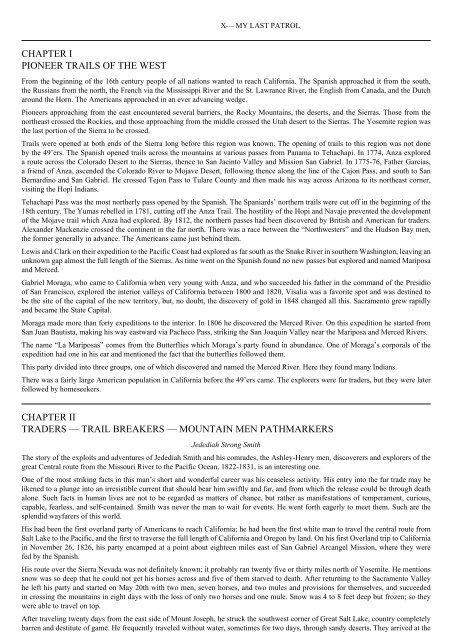

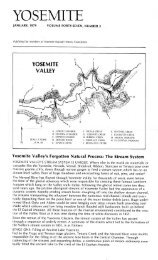
![(March 1982) [PDF] “We Are Pleased to Announce†- Yosemite Online](https://img.yumpu.com/51299748/1/190x242/march-1982-pdf-aeuroewe-are-pleased-to-announceaeur-yosemite-online.jpg?quality=85)
![[PDF] Old Horny, Yosemite's Unicorn Buck - Yosemite Online](https://img.yumpu.com/51269869/1/184x260/pdf-old-horny-yosemites-unicorn-buck-yosemite-online.jpg?quality=85)
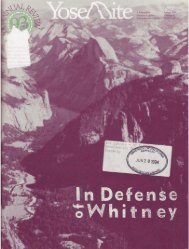
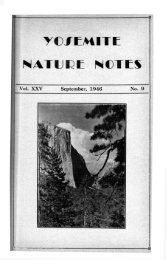
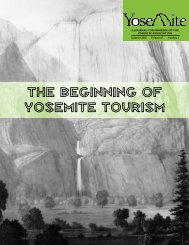
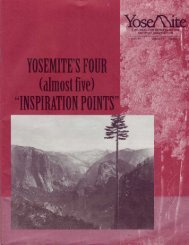
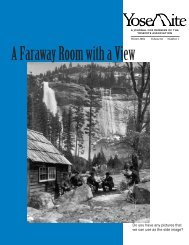
![1985 [PDF] - Yosemite](https://img.yumpu.com/48128837/1/184x260/1985-pdf-yosemite.jpg?quality=85)

